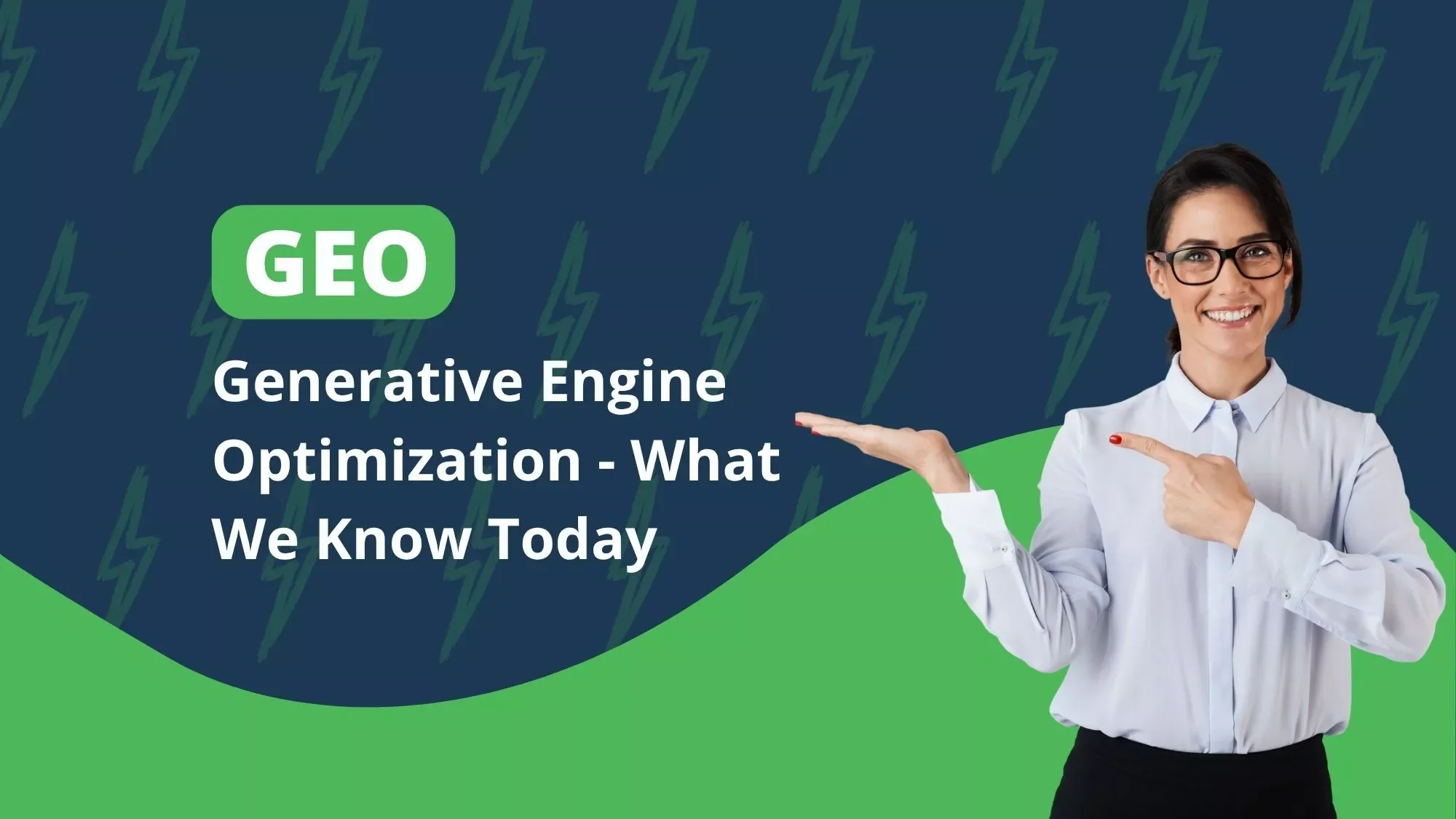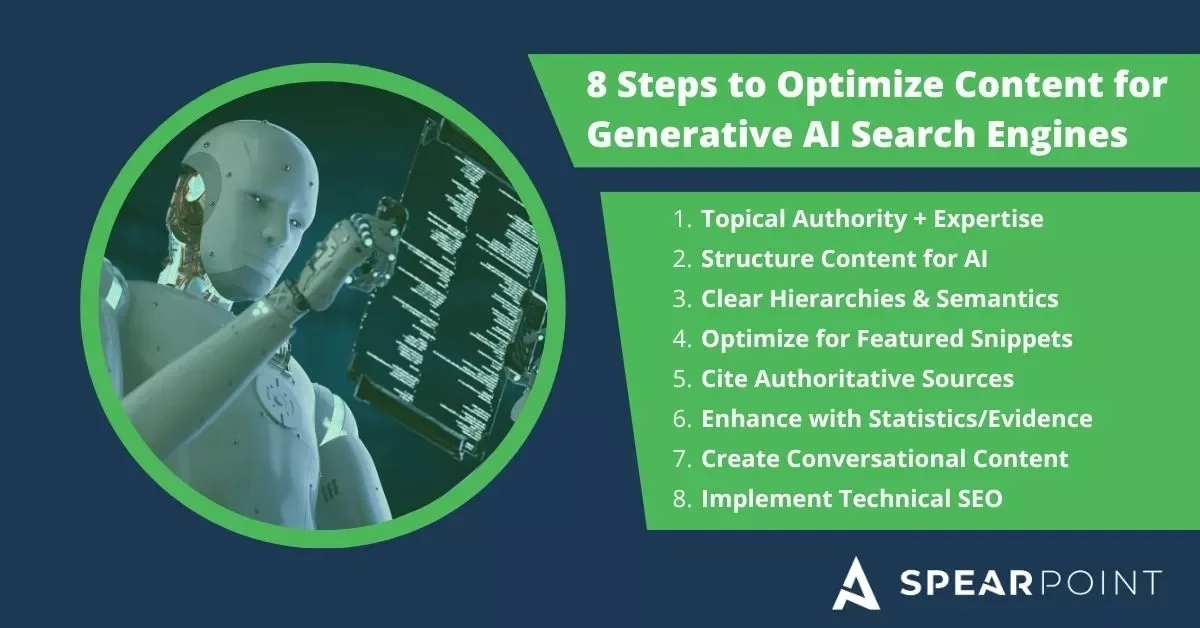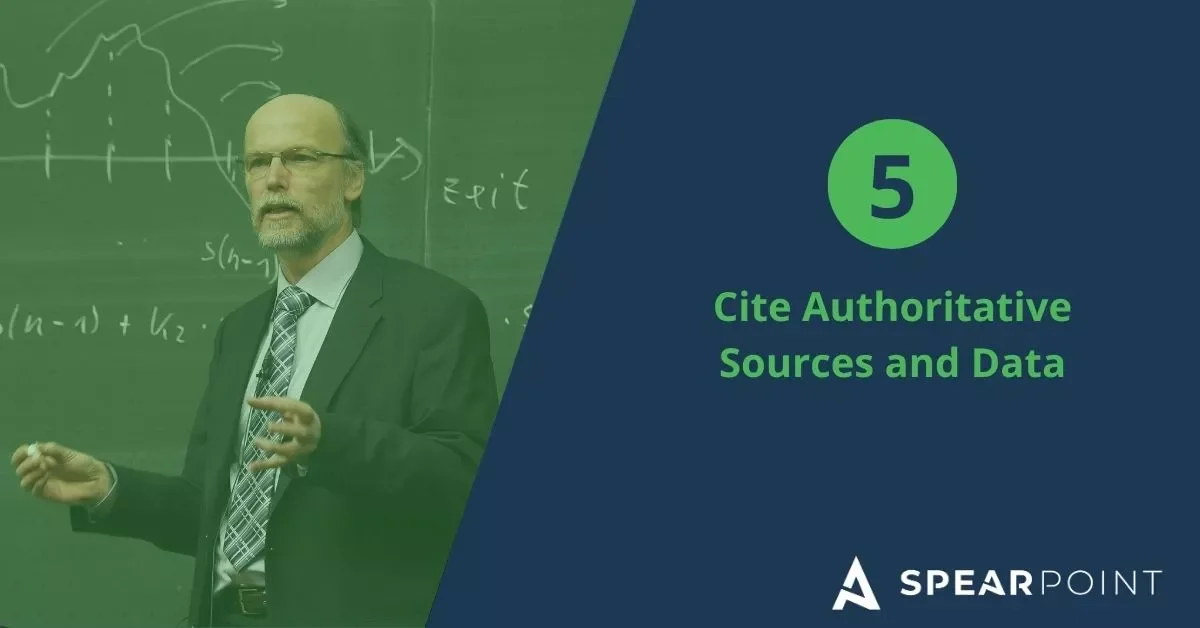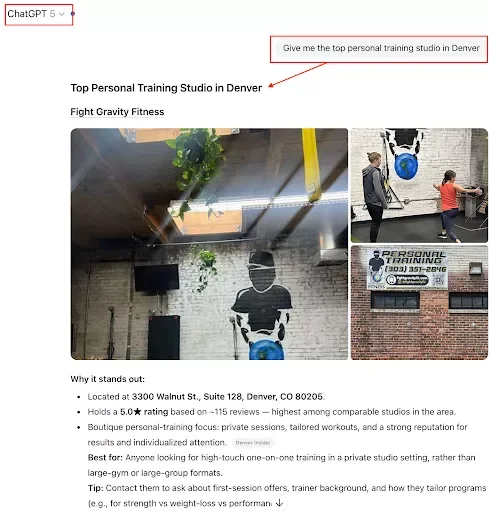Generative Engine Optimization (GEO) - What We Know Today
Search is fundamentally changing. While you refine meta descriptions and build backlinks, millions of users are bypassing traditional search engines entirely, turning to ChatGPT, Perplexity, and Google's AI Overviews for instant answers. Enterprise adoption of generative AI jumped to 71% by mid-2024, and 92% of Fortune 500 companies have already integrated these technologies. Your content might rank number one on Google, but if it's invisible to AI engines, you're missing a massive and rapidly growing audience.
Generative Engine Optimization represents the next evolution in digital visibility. It's not about abandoning SEO principles you've spent years mastering. Rather, GEO adapts those foundations for an environment where AI systems synthesize information, cite sources, and deliver answers without requiring users to click through to your site.
At SpearPoint Marketing: We've been testing GEO strategies since early 2024, monitoring citation patterns across ChatGPT, Perplexity, Google AI Overviews, and Gemini for clients in B2B SaaS, professional services, and marketing technology. We track over 200 queries weekly and have documented measurable improvements in AI citation rates for our portfolio.
This guide shares our expertise in proven strategies and our honest insights about what we're still learning in this rapidly evolving field.
Also Read:
5 Key Takeaways
GEO is the next evolution of SEO, not a replacement.
You’re no longer optimizing for positions but for citations in AI answers.
AI engines reward clarity, structure, and extractable facts.
Bullet points, FAQs, tables, and concise definitions dramatically increase citation likelihood.
Topical authority matters more than keyword optimization.
AI models care about depth, semantic coverage, and expert credibility, not keyword density.
GEO must be tailored to each AI platform.
ChatGPT, Perplexity, Google AI Overviews, and Claude all extract information differently.
Success metrics have changed.
Track AI visibility rate, citations, attribution placement, and AI-referred conversions, not rankings.
TL;DR
Generative Engine Optimization (GEO) focuses on making your content easily extractable, trustworthy, and cite-worthy for AI search engines like ChatGPT, Google AI Overviews, Perplexity, and Gemini. Unlike traditional SEO where you optimize for rankings and clicks, GEO optimizes for citations, attribution, and presence inside AI-generated answers.
To win, you must produce deeply structured, data-rich, expert-backed content with clear hierarchies, schema markup, and topical authority. Early adopters report higher conversions, stronger brand visibility, and an enduring competitive advantage as AI becomes the dominant search interface.
Table of Contents Show
A SEO Agency Partner is
MORE Affordable than you think.
Discover how Our Customers Grow Their Brands, Outshine Competitors, and Attract New Business
What Is Generative Engine Optimization (GEO)?
Generative Engine Optimization is a strategic process for optimizing content specifically for AI-driven search platforms. These systems like ChatGPT, Perplexity, Google Gemini, and Claude don't just rank pages but actively synthesize and present information.
Unlike traditional search engines that display lists of blue links, generative engines parse your content, extract key insights, and weave them into comprehensive answers. Your goal shifts from earning a top ranking position to being cited as an authoritative source within those AI-generated responses.
How Generative Search Engines Work
Generative search engines utilize advanced machine learning models to understand user queries at a deeper level than traditional keyword matching. When someone asks a question, these systems analyze intent, retrieve relevant information from multiple sources, and synthesize a cohesive response in real-time.
The process involves several steps. First, the AI interprets the query's semantic meaning, considering context and conversational elements that go beyond simple keyword recognition. Next, it retrieves information from its training data or, in platforms like Perplexity and Google AI Overviews, actively fetches current web content. Finally, it generates a response that directly addresses the user's intent, often including citations to source material.
This approach prioritizes context and relevance over traditional ranking signals. While backlinks and domain authority still matter for getting your content into the AI's knowledge base, how you structure and present information determines whether it gets selected for synthesis and citation.
Key Components of GEO
Successful generative engine optimization strategies rest on several foundational pillars that work together to maximize AI visibility.
Content clarity and structure top the list. AI models excel at extracting information from well-organized material featuring clear headings, logical flow, and scannable formats. Your content must be digestible not just for human readers but for algorithms parsing meaning and relationships between concepts.
Authoritative sourcing and data enrichment prove equally critical. Generative engines increasingly prioritize content backed by credible citations, expert quotes, and verifiable statistics. When your material references reputable studies or industry authorities, AI systems treat it as more trustworthy and cite it more frequently.
Technical optimization remains fundamental. Structured data through schema markup, clean HTML, fast load times, and mobile responsiveness all influence whether AI crawlers can access and properly interpret your content. Conversational alignment matters too, writing in natural language that mirrors how people ask questions increases your chances of being featured in AI-generated responses.
GEO vs. SEO: Understanding the Shift
The relationship between generative engine optimization and traditional SEO isn't adversarial. It's evolutionary. Both disciplines aim to increase content visibility and drive business results, but they target different discovery mechanisms and require distinct tactical approaches.
Core Differences Between GEO and SEO
Traditional SEO focuses on improving rankings in search engine results pages, aiming to drive users to click through to specific websites. Success means appearing in position one, two, or three for target keywords. GEO's primary goal? Getting content cited directly in AI-generated responses where the answer is often given in the conversation itself, and users may never visit your site.
The content approach differs fundamentally. SEO content has traditionally been keyword-focused, with narrative flow and persuasive elements. GEO-optimized content needs to be fact-rich and citation-heavy, making it easier for AI systems to extract and synthesize information. This requires explicit structuring through concise answers, bullet points, and FAQ formats that enable AI to readily understand and reproduce key facts.
Success metrics diverge significantly. In traditional SEO, you measure keyword rankings, organic website traffic, and click-through rates. Generative engine optimization focuses on frequency and prominence of citations in AI-generated answers, visibility within generative engine summaries, and how often content surfaces as a source even when users never click through.
Technical priorities shift as well. SEO emphasizes crawlability, page speed, and backlinks. GEO adds heavy emphasis on entity optimization, comprehensive schema markup, and clear definition of topics so AI models can accurately pick up and attribute authoritative information. Author credentials, transparent sourcing, and factual precision become more critical.
Why Traditional SEO Tactics Fall Short for AI
Many established SEO tactics prove ineffective or even counterproductive when applied to generative engines. Keyword density optimization often works against GEO goals. AI models trained on natural language patterns can identify and deprioritize content that feels artificially stuffed with keywords. They favor material demonstrating broad topical coverage through related concepts and synonyms rather than repetitive keyword usage.
Backlink-focused strategies face diminishing returns. While external links still signal authority, 80% of sources cited by AI search platforms aren't present in Google's top results, with only 12% overlap. This means aggressive link building alone won't guarantee AI visibility.
Content that buries information deep within long-form articles struggles in generative contexts. AI platforms prioritize clear, immediate answers positioned prominently on the page. The traditional SEO blog format (hook, background, buildup, then answer) needs restructuring.
Single-page optimization falls short. Generative engines assess topical authority across your entire domain. Comprehensive coverage of a subject area through interconnected, well-structured content performs better than isolated, keyword-targeted pages.
Integrating GEO Into Your Existing SEO Strategy
The most effective approach treats GEO and SEO as complementary disciplines rather than competing priorities. At SpearPoint Marketing, we emphasize building unified brand trust that enhances both search visibility and appearance in AI answers. This centers on consistency and positive reputation across web profiles, reviews, PR mentions, and authoritative citations.
Start by identifying overlapping optimization tactics. Earning third-party reviews, securing news mentions, and obtaining reputable citations boost both traditional search rankings and AI-generated response visibility. Rather than maintaining separate strategies, leverage these shared elements to maximize efficiency.
Adapt your content formats strategically. For SEO, continue prioritizing engaging, well-structured pages that drive conversions. For GEO, shift toward entity-rich, factually precise content that AI models can easily extract and cite. This involves using clearer hierarchies, more succinct answers, and enhanced schema markup.
Integrate local and brand-building efforts. Location-based reviews, directories, and map citations strengthen both SEO and GEO presence, ensuring relevance for traditional searches and AI-driven answers.
Most importantly, maintain continuous monitoring and iteration. Track both traditional SEO metrics and AI-specific visibility indicators. Watch how your content performs across generative engines, identify patterns in what gets cited, and refine your approach based on actual performance data.
Why Generative Engine Optimization Matters in 2025
The transformation isn't coming. It's here. ChatGPT attracted 4.7 billion monthly visits as of January 2025, far surpassing competitors and rivaling traditional search engines in reach. Global AI search platforms now serve 378 million active users, a figure projected to reach 1.2 billion by 2031. These aren't experimental users; they're mainstream consumers, professionals, and decision-makers who've fundamentally changed how they discover information.
Early adopters in B2B and SaaS are already seeing results. A smart home technology company that restructured content for AI platforms saw a 32% increase in qualified leads within six weeks, with AI-sourced visitors converting at 27% compared to 2.1% for traditional SEO traffic. Vercel now attributes 10% of new user sign-ups to referrals via ChatGPT citations in 2025.
The Rise of AI-Powered Search Behavior
User behavior patterns reveal the depth of this shift. Among Gen Z, 31% of searches are now performed on AI platforms rather than traditional search engines. An Adobe survey found 77% of Americans use ChatGPT as a search engine, with 24% preferring it to Google for information queries.
The reasons for adoption make sense. Generative engines provide immediate, comprehensive answers to complex questions. They synthesize information from multiple sources, saving users research time. They adapt to conversational follow-up questions, creating a more natural interaction than clicking through blue links.
However, trust remains a consideration. 63% of U.S. adults feel underwhelmed or remain unaware of AI-generated results, and 28% explicitly don't trust them. Brands that establish themselves as frequently cited, reliable sources within AI responses position themselves to benefit as trust grows.
Impact on Organic Traffic and Visibility
The traffic implications are significant and measurable. Google's AI Overviews drove a 61% drop in organic click-through rates and a 68% drop in paid CTR for informational queries since mid-2024. Users increasingly get answers directly on results pages.
Yet overall impressions of cited content increased by 49% year-over-year due to more queries triggering AI panels. The metric for success is shifting from clicks to being cited as an authoritative source within AI-generated answers. Visibility and brand recognition can actually increase even as traditional traffic patterns change.
Webflow reported 6-27X higher conversion rates for B2B prospects sourced from GEO-driven AI recommendations compared to regular organic search, showing the quality advantage of AI-referred traffic.
Business Benefits of Early GEO Adoption
Organizations implementing generative engine optimization strategies now gain several competitive advantages. First, they establish authority within AI responses before markets become saturated. Being consistently cited builds brand recognition that compounds over time.
Second, early adopters gain valuable learning about what works. AI search technologies evolve rapidly, and hands-on experience provides insights no amount of theory can replicate. Relixir AI achieved #1 ranking in AI-generated tool lists within 30 days of implementation, with over 100% increase in clicks from AI-generated search results.
Third, generative engine optimization often improves traditional SEO as well. The emphasis on clear structure, authoritative sourcing, comprehensive topical coverage, and technical excellence benefits both AI and human users.
Finally, forward-thinking GEO positions brands for continued relevance as search paradigms shift. Google's global search market share dipped below 90% for most of 2025, reflecting rising traction for AI-native search tools. Multi-platform visibility strategies provide more resilient foundations for long-term growth.
8 Steps to Optimize Content for Generative AI Search Engines
Effective generative search optimization requires a systematic approach spanning content strategy, technical implementation, and ongoing measurement. Success comes from understanding what AI systems prioritize when selecting content to cite and synthesize.
1. Establish Topical Authority and Expertise
Topical authority matters more in GEO than traditional SEO because AI systems assess credibility across your entire content library when deciding which sources to cite. Creating isolated keyword-targeted pages proves less effective than building comprehensive, interconnected resources that demonstrate deep subject matter expertise.
Start by identifying your core areas of expertise and mapping the full scope of topics within those domains. Rather than chasing high-volume keywords with thin content, develop in-depth resources that address the breadth and depth of subjects where you offer genuine insight.
Demonstrate expertise through original research, detailed analysis, and unique perspectives. AI engines increasingly prioritize content showcasing firsthand experience and proprietary insights over recycled information. Case studies, original data, expert commentary, and detailed methodologies all signal authority that generic overviews lack.
Real-world example: When working with a B2B SaaS client last year, we restructured their product comparison pages to lead with feature specifications in the first 150 words rather than marketing copy. We added HowTo schema and created FAQ sections addressing common evaluation criteria. Within 45 days, ChatGPT began citing them in 4 out of 10 tracked queries versus zero before, and Perplexity featured them in comparison tables. The key was making specifications extractable without requiring the AI to parse through promotional language.
2. Structure Content for AI Comprehension
How you organize information directly impacts whether AI systems can extract and utilize it effectively. While compelling narratives engage human readers, generative engines need clear structure that facilitates parsing, extraction, and synthesis.
Begin with direct answers to core questions. Place your most valuable insights early rather than building toward them through extensive background. AI models extract prominently positioned information more reliably than details buried deep within long-form content.
Break content into clearly labeled, focused sections. Each heading should communicate specific subject matter, helping AI understand relationships between different parts of your content. Avoid vague or clever headlines that obscure meaning.
Use hierarchical organization that reflects logical information architecture. Main topics merit H2 headings, subtopics use H3s, and specific details fall under H4s. This hierarchy helps AI models understand which concepts are primary and which are supporting details.
Lesson learned: We've found that FAQ content placed in the first 30% of a page gets cited significantly more frequently than FAQs buried at the bottom. For one professional services client, moving their FAQ section from the footer area to immediately after the introduction tripled their Perplexity citation rate within 60 days.
3. Use Clear Hierarchies and Semantic Markup
Implementing proper semantic markup through HTML5 elements and schema.org vocabulary provides explicit signals about content meaning and structure. While AI models can infer relationships through natural language processing, structured data removes ambiguity and ensures accurate interpretation.
Apply schema markup strategically across different content types. Article schema defines basic properties like headline, author, and publish date. HowTo schema outlines step-by-step instructions. FAQ schema explicitly marks questions and answers. Review schema provides product or service evaluations.
Use semantic HTML5 elements consistently. The <article> element contains standalone content pieces. The <section> element groups related content thematically. The <aside> element holds tangentially related information. These elements provide structural meaning beyond visual presentation.
Create clear entity relationships by properly marking up people, organizations, places, and concepts. When you mention a company, product, or person, use appropriate schema to identify that entity explicitly.
4. Optimize for Featured Snippet Formats
Featured snippets in traditional search serve as excellent templates for GEO-friendly formatting. The structures Google selects for featured snippets (concise definitions, bulleted lists, numbered steps, tables) also work well for AI extraction and synthesis.
Answer common questions directly in 40-60 word paragraphs. This length provides enough detail for utility while remaining concise enough for easy extraction. Place these question-and-answer blocks prominently.
Use bulleted or numbered lists for sequential information, options, or categories. Keep each list item focused and concise, ideally one to two sentences. Create comparison tables when presenting information about multiple options, products, or approaches.
5. Cite Authoritative Sources and Data
AI systems increasingly factor source credibility when selecting content to cite and synthesize. Material referencing reputable studies, recognized experts, and verifiable data receives preferential treatment over unsupported claims or generic statements.
Incorporate citations from recognized authorities in your field. Academic research, industry reports from established analysts, government data, and commentary from respected practitioners all strengthen your content's credibility. When citing sources, provide specific attribution including author names, publication titles, and dates.
Link to your sources directly, making it easy for AI systems to verify claims and understand the evidence supporting your positions. External links to authoritative sources demonstrate transparency and intellectual rigor that AI platforms value.
6. Enhance Content with Statistics and Evidence
Specific, verifiable data dramatically strengthens content in AI evaluation. Quantifiable facts provide concrete information that AI systems can extract, attribute, and synthesize more reliably than vague generalizations or subjective opinions.
When incorporating statistics, present them with clear context and attribution. Rather than stating "most businesses see positive results," specify "content appearing in AI-powered search channels converts at 4.4 times higher rates than standard organic search traffic." The specific data point, properly sourced, provides far more value and credibility.
Update statistics regularly to maintain accuracy and relevance. AI systems increasingly prioritize current information, particularly for topics where data changes frequently. Schedule periodic content audits to refresh key data points.
7. Create Conversational, Natural Language Content
Generative AI platforms excel at understanding natural language, making conversational content styles more effective than rigid, keyword-stuffed approaches. Write as if explaining topics to a knowledgeable colleague rather than optimizing for algorithmic keyword matching.
Address user questions directly using the language people actually use when seeking information. Instead of targeting the keyword "GEO implementation strategies," answer the question "How do I optimize content for generative AI search engines?"
Maintain an active voice and direct address. Active voice statements like "You need to structure content clearly" communicate more directly than "Content should be clearly structured by marketers."
8. Implement Technical SEO Fundamentals
Strong technical foundations remain essential for generative engine optimization. AI crawlers need access to your content, but they process and evaluate it differently than traditional search bots.
Ensure AI-specific crawlers can access your site. Check your robots.txt file to confirm you're not blocking bots like GPTBot (OpenAI), Google-Extended (Google's AI training), CCBot (Common Crawl), and other AI crawlers.
Maintain fast page load speeds and mobile optimization. Structure your URL hierarchy logically and use descriptive, readable URLs. Implement proper canonical tags, especially for sites with duplicate or similar content across multiple URLs.
Monitor and fix crawl errors regularly through Search Console and similar tools. Broken links, server errors, and other technical issues prevent AI systems from accessing content, creating invisible gaps in your potential visibility.
Platform-Specific GEO Strategies
Each generative AI platform processes, evaluates, and presents content differently. While core GEO principles apply broadly, understanding platform-specific preferences and behaviors helps you optimize for maximum visibility across the AI search landscape.
Key trade-off we've observed: Content optimized heavily for ChatGPT citations (very list-heavy, comparison-focused formats) sometimes underperforms in Google AI Overviews, which favors more narrative-driven answers with embedded statistics. For clients targeting both platforms, we recommend a hybrid approach: lead with a direct answer paragraph (for Google), follow with structured lists or comparisons (for ChatGPT), then provide narrative context and examples throughout.
Optimizing for ChatGPT and OpenAI Search
ChatGPT's massive user base, 800 million weekly active users by April 2025, makes it a critical platform for GEO efforts. OpenAI's search functionality increasingly competes directly with traditional search engines, particularly for research and information queries.
Target authoritative list articles and comprehensive reviews. ChatGPT heavily relies on trusted comparison lists, "best of" articles, and detailed product or service evaluations when making recommendations. Creating high-quality comparison content or securing mentions in recognized publications significantly improves visibility.
Get listed in major knowledge directories that OpenAI's systems use for verification. Wikipedia, Bloomberg, Crunchbase, and similar authoritative databases serve as reference points for validating information.
Align content to real-world scenarios and use cases. Structure material to mirror natural, contextual questions rather than isolated keyword targets. Describe problem-solution scenarios, walk through decision frameworks, and address the "why" behind recommendations.
Optimizing for Google AI Overviews (SGE)
Google's AI Overviews represent the company's integration of generative AI into traditional search results. These summaries appear above standard organic listings for many queries, fundamentally changing how users interact with search results.
Prioritize robust schema markup across all relevant content types. Google's AI relies heavily on structured data to understand, categorize, and summarize content for Overview boxes. Implement FAQ schema for question-answer content, HowTo schema for instructions, Article schema for editorial content, and Product schema for commercial pages.
Display expert credentials and qualifications prominently. Google's AI Overviews strongly favor content demonstrating E-E-A-T signals. Clear author bios featuring relevant expertise, credentials, and experience improve selection likelihood.
Format content in answer-centric styles with clear, direct responses to popular queries. Place concise answers early in your content, then provide detailed context and explanation.
Maintain content freshness through regular updates. Google's generative AI prioritizes recently refreshed information, particularly in dynamic industries where facts and best practices evolve.
Optimizing for Perplexity AI
Perplexity's approach emphasizes source transparency and citation clarity, making it particularly important for brands seeking attributed visibility in generative search. The platform explicitly shows where information comes from, making attribution more visible than in other AI systems.
Structure content for easy summarization and clear attribution. Use crisp headlines, prominent facts, and visible citations throughout your material. Perplexity highlights sources and traceable claims in results.
Phrase content and headlines as direct answers to specific questions. Rather than clever or abstract titles, use straightforward question-based formats that mirror user intent. "What is generative engine optimization?" proves more effective than "The New Search Paradigm" for this platform's extraction logic.
Maintain dedicated Q&A sections on key pages addressing common queries within your topic area. These explicitly formatted question-answer blocks increase direct answer extractability.
Optimizing for Claude and Anthropic Models
Claude's approach prioritizes safety, accuracy, and ethical presentation of information. While less documentation exists for Claude-specific optimization compared to ChatGPT or Google, certain patterns have emerged.
Present content with comprehensible, unbiased language that demonstrates balanced consideration of topics. Claude's training emphasizes ethical transparency and careful handling of sensitive subjects. Avoid hyperbole, one-sided arguments, or sensationalized claims.
Use plain language and minimize unnecessary jargon. While you shouldn't oversimplify complex topics, explaining concepts clearly without excessive technical terminology improves Claude's ability to comprehend and explain your content accurately.
Break down processes into explicit, logical steps for instructional or technical content. Attribute claims and statistics to traceable external sources.
(Website Overview by Waikay)
Measuring Generative Engine Optimization Performance
Traditional SEO metrics like rankings and click-through rates don't fully capture GEO effectiveness. The generative engine optimization tools and measurement approaches emerging in 2024-2025 focus on attribution, citation frequency, and share of voice within AI-generated content.
How we track performance: At SpearPoint Marketing, we monitor 50 core queries weekly for clients across ChatGPT, Perplexity, and Google AI Overviews using a combination of Semrush's AI Visibility Toolkit, Waikay, and manual audits. What surprised us most: only 8-12% of brand citations overlap between ChatGPT and Google Gemini. This means you need platform-specific strategies; success on one platform doesn't automatically translate to others.
Key GEO Metrics to Track
AI-Generated Visibility Rate measures how frequently your content or brand appears in AI-generated responses across platforms. Track this for your target query set—the questions and topics where you want to establish authority. Brands with mature GEO strategies see mention rates of 19-27% for high-intent, category-defining queries, with first-position presence above 10% indicating leading investment.
Citation and attribution rates quantify how often AI platforms directly cite or link to your content when synthesizing answers. Industry data suggests average citation rates of 18-22% for reference-focused queries in areas like health, legal, or finance, though this drops to 10-14% for general informational queries. Track both citation frequency and positioning; earlier citations in AI responses drive more visibility and perceived authority.
Share of voice within AI responses reveals your prominence compared to competitors. Calculate this as the proportion of tracked AI responses mentioning or linking your brand. Mature brands average 12-20% share of voice across GEO-tracked results, with top performers exceeding 25% for their primary authority topics.
Engagement metrics for AI-referred traffic measure what happens after users encounter your brand in AI responses. While traditional click-through rates decline as AI provides more complete answers, post-AI-interaction engagement reveals business impact. Track AI referral traffic, dwell time, conversion rates, and how these visitors behave compared to traditional search traffic.
Tools for Monitoring AI Search Visibility
Several specialized platforms launched in 2024-2025 specifically for tracking generative engine optimization performance across multiple AI search engines.
Semrush AI Visibility Toolkit integrates AI search visibility tracking with established SEO tools. It monitors brand mentions across ChatGPT, Google AI Overviews, Perplexity, and Gemini, tracks sentiment, offers competitor share-of-voice analysis, and provides optimization suggestions directly in the dashboard.
Peec AI focuses exclusively on GEO analytics and AI search visibility. The platform tracks percentage-based brand visibility across multiple countries and languages, benchmarks against competitors, analyzes share of voice, and delivers real-time alerts for citation frequency changes.
Writesonic GEO serves as a comprehensive generative engine optimization platform tracking brand visibility and share-of-voice across major AI search engines. Features include real-time sentiment analysis, prompt and competitor tracking, product tracking specifically for ChatGPT Shopping, and instant optimization recommendations.
Surfer AI Tracker delivers centralized visibility data across Google AI Overviews, Bing Copilot, ChatGPT, and Gemini. It allows monitoring brand citations, auditing content losing AI visibility, and streamlining insights from multiple engines in one dashboard.
Analyzing Citation and Attribution Rates
Understanding how and why AI systems cite your content reveals optimization opportunities beyond simple visibility metrics. Deep analysis of citation patterns helps you refine content strategies for better attribution rates.
Examine which content types and formats receive citations most frequently. Pages over 3,000 words with comparison formats and clear subheadings generate three times the traffic and are cited significantly more often. Structured formats facilitate extraction, making them more attractive to AI systems synthesizing answers.
Analyze what information gets extracted from your cited content. Do AI systems pull statistics, quotes, definitions, or methodologies? Understanding what elements they find most valuable helps you emphasize those components in future content development.
Track where in AI responses your citations appear. Top-positioned citations receive more visibility and implied authority than those buried at the end of long responses.
Monitor citation stability over time. Consistent citation across multiple queries and time periods indicates strong topical authority, while sporadic mentions suggest opportunities to deepen coverage or strengthen expertise signals.
Common GEO Mistakes to Avoid
Even organizations investing in generative search optimization often undermine their efforts through preventable mistakes. Recognizing these pitfalls helps you allocate resources more effectively.
Treating GEO as completely separate from SEO represents perhaps the most widespread error. Creating isolated GEO-optimized content disconnected from core SEO activities wastes effort and misses compounding effects on site authority. Modern best practice integrates GEO into existing SEO workflows, recognizing that strong technical foundations, topical authority, and quality signals benefit both traditional and AI-powered search visibility.
Over-optimizing for keywords instead of semantic coverage actively harms GEO performance. AI systems trained on natural language patterns identify and deprioritize artificially keyword-stuffed content. They favor material demonstrating broad topical understanding through related concepts, synonyms, and comprehensive coverage.
Failing to provide direct, concise answers frustrates both users and AI systems. Burying key information deep within content or emphasizing background over solutions reduces the chances of being featured in AI-generated responses.
Ignoring author authority and brand signals significantly limits AI visibility. Thin author bios, missing credentials, or no clear expertise indicators cause AI engines to favor competitors with stronger authority markers.
Critical trade-off many miss: GEO requires 40% or more in upfront resource investment compared to traditional SEO, encompassing deeper content, advanced schema markup, multi-platform monitoring, and specialized analytics. There's a shortage of practitioners skilled in schema development and RAG (retrieval-augmented generation) configuration. Organizations that underestimate this resource gap often launch incomplete GEO programs that deliver poor results, then abandon the strategy prematurely.
Another risk we're monitoring closely: AI platforms sometimes misrepresent or extract information out of context from authoritative content, especially for regulated sectors like finance, healthcare, or legal services. You have less control over how your content is interpreted or attributed by AI, creating potential brand integrity issues. We recommend clients in sensitive industries implement regular audits of how their content appears in AI responses and maintain clear disclaimers on their source material.
The Future of Generative Search and GEO
The pace of change in AI-powered search shows no signs of slowing. The global generative AI market is projected to exceed $66.6 billion by the end of 2025 and reach $109.4 billion by 2030, with a compound annual growth rate of 37.6%. This massive investment drives rapid evolution in capabilities, adoption, and competitive dynamics.
Emerging Trends in AI Search Technology
Hybrid and agentic AI models represent the next evolution, blending real-time web indexing with LLM training data. Systems like ChatGPT and Google Gemini increasingly adjust responses depending on whether queries require foundational knowledge or current information.
Conversational and multi-modal search capabilities are expanding rapidly beyond text. Voice queries, image-based searches, and video content all integrate into unified AI search experiences. Optimizing for these additional modalities requires rethinking content formats.
Industry-specific and domain-adapted search solutions proliferate as vertical applications prove their value. Retail, healthcare, finance, and other sectors develop specialized AI search tools tailored to their unique needs. 41% of US consumers already show interest in AI-powered retail search.
Privacy and data security concerns grow alongside AI search adoption. Transparent sourcing, clear data handling practices, and ethical AI use become competitive differentiators as scrutiny increases.
The disruption of traditional SEO and ad models accelerates.Google's AI Overviews led to an 8.9% average drop in clicks for cited URLs, fundamentally changing how publishers monetize content.
Struggling with SEO & GEO?
Discover How SpearPoint Grows Brands—and Drives Conversions
Preparing Your Content Strategy for What's Next
What we're still learning: GEO is emerging rapidly, and several questions remain open. First, optimization tactics that work for one platform can hurt performance on another; for example, technical accuracy optimized for Google's Gemini may reduce creative output favored by ChatGPT. We're actively testing content variations across platforms to identify the optimal balance.
Second, measurement remains challenging. Users often receive direct answers without visiting source sites, creating a "zero-click" reality where traditional metrics have limited relevance. We're experimenting with alternative ROI frameworks, but attribution for GEO efforts that take 6-12 months to show results remains imperfect.
Third, the optimization goalposts shift regularly as platforms update models or change content selection criteria. What works today may prove counterproductive tomorrow. We'll update our findings as we gather more data.
Adaptability becomes your most valuable asset as generative search continues evolving. Rather than betting on specific platforms or tactics, build flexible systems that allow rapid experimentation and adjustment based on actual performance data.
Invest in building genuine topical authority that transcends any single platform. Deep expertise, original research, and comprehensive coverage create value regardless of how search technologies evolve.
Develop continuous monitoring and learning systems rather than one-time optimization projects. Regularly test how your content performs across different AI platforms, identify what's working, and iterate quickly.
Maintain presence across diverse platforms rather than over-concentrating on any single channel. Global search market fragmentation accelerates as users adopt multiple discovery methods. Visibility across ChatGPT, Perplexity, Google AI Overviews, and emerging platforms provides resilience.
Balance short-term tactics with long-term brand building. Quick wins from GEO optimization matter, but sustainable visibility comes from establishing your organization as a recognized authority.
At SpearPoint Marketing, we help businesses navigate this transition by integrating GEO into comprehensive digital strategies that build authority, drive visibility, and deliver measurable results. Rather than treating generative search as a separate discipline, we emphasize the overlapping tactics that strengthen both traditional SEO and AI-powered discovery: authoritative content, consistent brand presence, technical excellence, and continuous optimization based on real performance data.
The shift to generative search isn't replacing traditional SEO overnight, but the trajectory is clear. By understanding what is generative engine optimization, implementing proven strategies, and maintaining adaptability as technologies evolve, you position your brand for sustained visibility regardless of how users choose to discover information.
About the Author
Jesse McFarland is the founder of SpearPoint Marketing, a conversion-focused SEO and GEO agency helping B2B, professional services, and SaaS brands turn search visibility into a measurable pipeline. With over 17 years of digital marketing experience spanning agency and in-house leadership, Jesse specializes in technical SEO, content strategy, CRO, and Digital PR. Since early 2024, his team has tracked hundreds of weekly queries across ChatGPT, Perplexity, Google AI Overviews, and Gemini, documenting measurable gains in AI citation rates for clients.
Jesse is a thought leader and speaker on Generative Engine Optimization (GEO) and emerging SEO trends, helping brands adapt their strategies for the next era of AI-powered search.
About Jesse. LinkedIn











